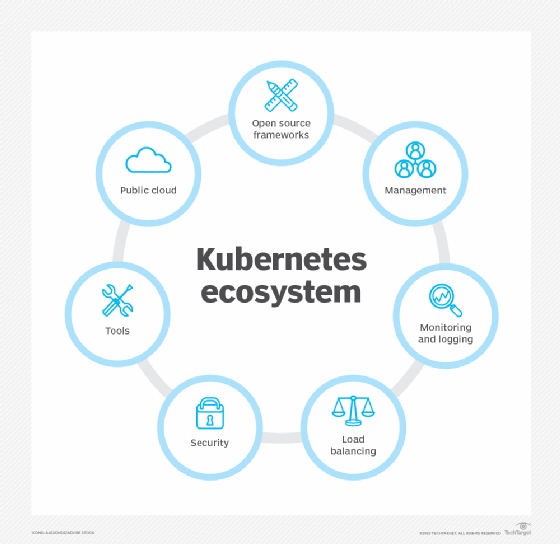
Getty Images
Handling Kubernetes challenges in complex cloud environments
Multi-cloud Kubernetes deployments present management, operations and cost issues for even the most seasoned cloud teams, but the right strategy can combat those challenges.
The multi-cloud model is becoming increasingly popular in the IT industry, and it's an ideal platform and use case for Kubernetes orchestrations to serve complex applications.
But Kubernetes is a challenge unto itself for enterprises -- and in multi-cloud deployments, unexpected issues can arise that leave even the most seasoned teams stumped. By proactively planning for potential issues, however, organizations can manage this perfect storm of Kubernetes and cloud complexity.
Barriers to Kubernetes adoption in multi-cloud environments
The first step is acknowledging the barriers to Kubernetes adoption in multi-cloud environments. Such proactivity is the mark of a mature, cloud-first organization and the ideal way to get challenges under control.
The most significant barrier to Kubernetes adoption is the complexity of configuring and synchronizing Kubernetes clusters across all cloud platforms. Each cloud service provider (CSP) has its own approach to both Kubernetes configuration and cloud services, and finding an expert on each platform is rarely feasible. This makes it challenging to move workloads between platforms, raises the likelihood of vendor lock-in and limits organizations' ability to take advantage of each CSP's strengths.
In addition, Kubernetes security is a beast even in a single-cloud environment. Extending Kubernetes across a multi-cloud environment requires teams to wrangle and seek some mastery over each cloud's security protocols and policies to ensure consistency across clusters. Not meeting this challenge increases the risk of vulnerabilities and data breaches in multi-cloud environments.
The cost implications of Kubernetes in a multi-cloud environment are especially problematic, as each CSP has its own complex pricing structure for cloud services. Focus on cost implications throughout your planning and the entire project lifecycle to avoid surprises come billing time.
Addressing Kubernetes adoption challenges in multi-cloud environments
To mitigate potential problems when running Kubernetes in a multi-cloud environment, start small and build internal teams' skills. Tackling challenges proactively and methodically helps ensure security and compliance across cloud environments while staying in budget.
Take a cloud-agnostic management approach
The first step to addressing Kubernetes adoption challenges is to take a cloud-agnostic approach that abstracts the underlying multi-cloud infrastructure, with the aim of reducing vendor lock-in.
To start, consider bringing on expertise from a third-party service or firm designated as a Kubernetes Certified Service Provider. Another tactic is to implement a common Kubernetes platform to reduce the complexity of moving workloads across cloud environments.
One example is Kubermatic Kubernetes Platform, a cloud-agnostic Kubernetes management platform. Alternatively, Kubernetes Federation -- still in beta -- is a native Kubernetes feature that supports managing multiple Kubernetes clusters as a single entity, facilitating application deployment and management across multiple clusters in a multi-cloud environment.
The GitOps model can also provide a consistent, auditable way to manage Kubernetes clusters in a multi-cloud environment. However, adopting GitOps often requires a significant investment in time, tools and processes that might not be worthwhile for all organizations.
Implement a multi-cloud Kubernetes management platform
A multi-cloud management platform is an integral tool to counter Kubernetes challenges in complex cloud environments. Find a tool that offers teams a unified view of the IT environment, including security, operations and management features, and reporting.
Examples of multi-cloud management tools to consider include the following:
- Google Anthos is a hybrid and multi-cloud platform that enables IT teams to manage and deploy applications across Google Cloud, AWS and Microsoft Azure.
- Red Hat OpenShift is an open source Kubernetes-based container platform that organizations can deploy on premises or in the cloud, including AWS, Google Cloud and Azure.
- SUSE Rancher is an open source alternative to Anthos and OpenShift for managing and orchestrating Kubernetes clusters across a multi-cloud environment.

Automate Kubernetes management tasks
The DevOps mantra "automate, automate, automate" applies when managing Kubernetes challenges in a multi-cloud environment. Automation helps ensure Kubernetes clusters are correctly configured and synchronized across CSPs.
Look for ways to simplify management tasks and reduce manual intervention in Kubernetes and multi-cloud workflows. Audit automation strategies regularly, and be ruthless about it -- apply any lessons that teams learn about management and operations in the organization's complex cloud environment.
Focus on continuously improving security
When implementing Kubernetes in a multi-cloud environment, security is paramount, so continue to reaffirm teams' commitment to a continuous improvement approach. Ensuring Kubernetes cluster security requires implementing strong authentication, data encryption at rest and in transit, and network segmentation.
Optimize Kubernetes costs
When running Kubernetes in a multi-cloud environment, establish a cost optimization method that enables teams to choose the most effective CSP for each workload.
Kubecost can break down costs by namespace, deployment and services, across on-premises environments and major CSPs. Users can also view costs across multiple clusters in a multi-cloud environment in a single view or via a single API endpoint. There's also Kubecost Cloud -- now in public beta -- which supports AWS, Azure, Google Cloud and on-premises clusters.
Although Kubecost is a popular choice, it's not the only option. Yotascale ingests data across clouds and offers a single-pane view of cloud costs for containerized and noncontainerized workloads. In addition, Morpheus is a hybrid cloud management platform that includes Morpheus Kubernetes Service, which integrates with Azure Kubernetes Service and Amazon Elastic Kubernetes Service to support existing Kubernetes deployments.








